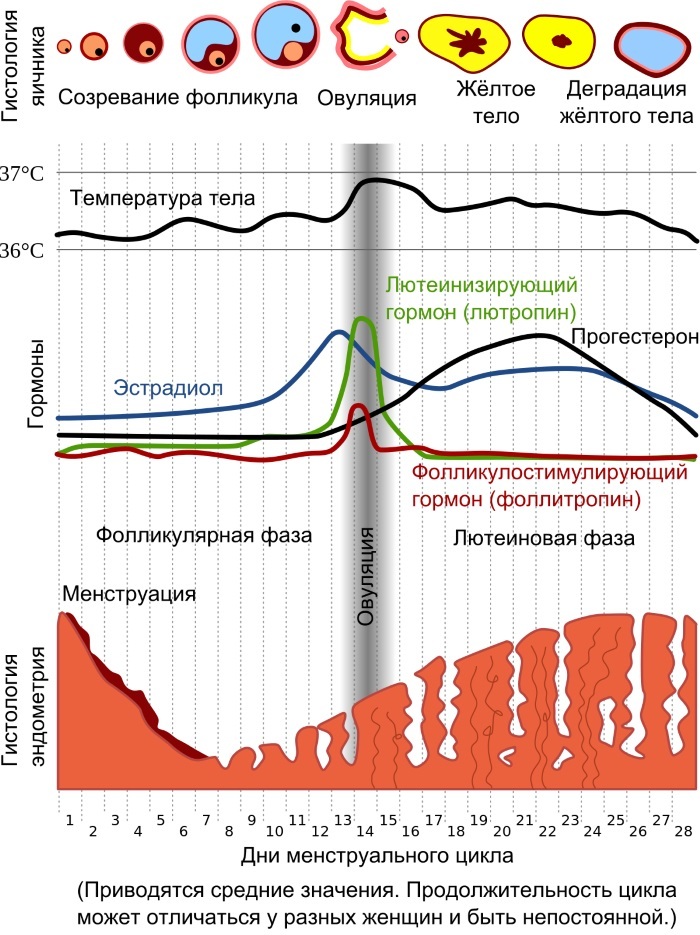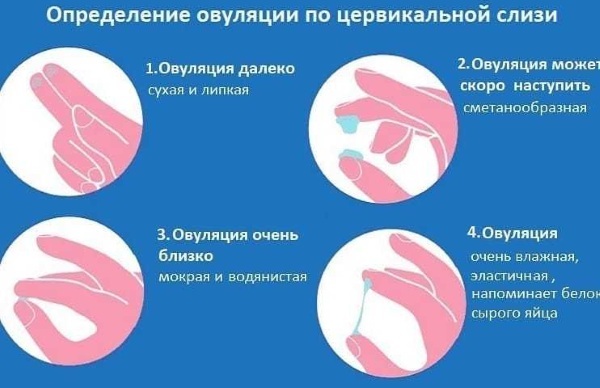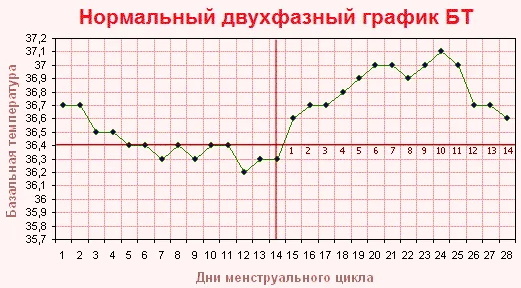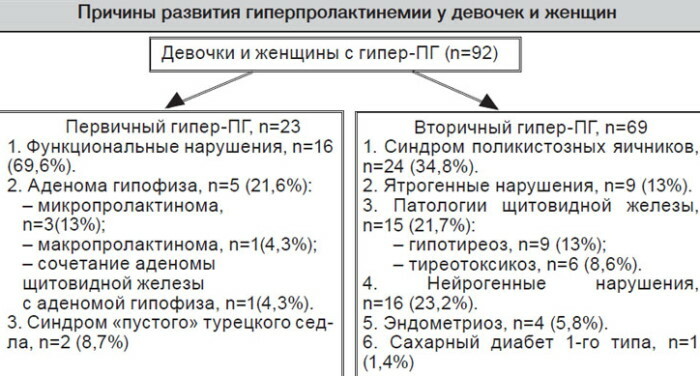Content
- Phases of the menstrual cycle
- Follicular
- Ovulatory
- Luteal
- How many days does a normal cycle last?
- Duration of menstruation
- When does ovulation occur
- How to calculate
- The day of the next period
- Ovulation day
- Safe days
- Cycle regularity
- Menstrual Cycle Videos
Count own menstrual cycle is necessary in order to control your own health. This is due to the fact that most gynecological pathologies are caused by a violation of the cycle. Therefore, during a medical examination, most women are interested in the duration and frequency of critical days.
Phases of the menstrual cycle
The cycle in women can be counted from the first day of menstruation, which often lasts approximately 3-7 days.
The cycle has 3 phases:
- follicular;
- ovulatory;
- luteal.
Follicular
The phase takes effect from the beginning of the appearance of blood secretions. At this stage, a follicle is formed, from which an egg cell is released.  The phase lasts about 14 days. However, it can be active from 7 to 22 days in relation to the individual characteristics of the female body.
The phase lasts about 14 days. However, it can be active from 7 to 22 days in relation to the individual characteristics of the female body.
Ovulatory
Lasts no more than 3 days. At this stage, ovulation occurs. As a result, the egg cell leaves the ovary and enters the fallopian tube due to the rupture of a mature follicle. If in this phase the sperm have reached the tubes of the uterus, passed through the membranes of the egg, fertilizing it at the same time, the woman is able to become pregnant.
Luteal
The phase lasts for 13-14 days. Instead of an egg that has left the ovary, a corpus luteum is formed, represented as a temporary endocrine gland that produces the hormone progesterone. It is formed to prepare the body for the changes that may occur due to a possible pregnancy.
How many days does a normal cycle last?
The cycle of menstruation is associated with periodically appearing changes in the female genital organs, which guarantee maturation. eggs in the ovaries and the modification of the uterine mucosa for the future bearing of an egg that was fertilized. Due to periodic changes in the female body, sex hormones appear.
The optimal cycle can last from 21 to 40 days. For many women, it lasts about 28 days, while it is called the ideal cycle, which coincides in duration with the lunar.
The regular cycle of less than 24 days is short. If it lasts more than 38 days, it is called long. However, according to other data, duration of less than 22 days is a shortened cycle, and more than 34 days is a long one. Moreover, if the critical days are constant and the woman's cycle has always been like this, it is normal.
If the duration of the cycle has increased to 35 days, it is lengthened. Therefore, it is necessary to find out the factors, since an extended cycle is considered pathological.
If the menstrual cycle fails, the interval between menstruation will increase to 40 days. Moreover, they will be regular or irregular. The reason lies in pathological disorders of the functioning of the ovaries.

If there is no menstruation for 6 months or more, amenorrhea associated with congenital malformations of the genital organs is established.
Duration of menstruation
Normal spotting lasts for 3-7 days. If the menstruation is lengthened or shortened, then there are pathologies associated with the reproductive system. They can also appear with the use of certain medicines.
The following problems are considered to be the reasons for very long periods:
- ectopic pregnancy;
- hyperplasia of the uterus and cervix;
- fibroids, polyps or cancer problems;
- pathologies associated with inflammation of the reproductive organs;
- poor blood clotting;
- failure in the production of sex hormones, as well as pathologies associated with the thyroid gland.
If your period is short, the following factors may affect it:
- inflammation of the pelvic organs;
- defects of the uterine walls that appeared during difficult childbirth, abortion or operations;
- lack of hormones associated with a reduction in the work of the ovaries and pituitary gland;
- the structure of the reproductive system, due to congenital features;
- endometriosis.
Often, the duration of menstruation can change in those women who have excess body weight or disorders caused by the activity of the immune system.
When does ovulation occur
The female menstrual cycle makes it possible to count the days when ovulation occurs. This is required in order for it to be permissible to determine the appropriate time for fertilization or prevention of pregnancy. The ovulatory phase continues when the follicle ruptures and until the ovum enters the fallopian tubes, where it can be fertilized.
It is impossible to determine the exact duration of ovulation, since it can change in every woman in every cycle. Basically, the process lasts for 16-32 hours. The viability of the oocyte released from the follicle reaches an average of 12-48 hours.
If the vital activity of the egg is very short, the sperm are able to maintain vigorous activity for up to a week. If sexual intercourse occurred a day or two before ovulation, fertilization of the egg with sperm cells that are in the fallopian tubes and retain their vital activity can occur. On the basis of this, a calendar method of protection is compiled, namely, the calculation of the dangerous period: 3 days before and the same number of days after ovulation.
You can find out the approximate ovulatory days with a simple count. Ovulation occurs at the end of the follicular phase. To identify ovulatory days, you need to know the length of the constant cycle.

The length of the first phase will be different for each woman and varies from 10 to 18 days. However, the duration of phase 2 for all will correspond to 14 days. To establish ovulation, you need to subtract 14 days from the cycle length. For example, if you subtract 14 from 28 days of the cycle, the 14th day of the cycle comes out. It is on this day that the release of the egg takes place. If you subtract 14 from a cycle with a length of 32 days, you get the 18th day of the cycle, which is the day of ovulation.
However, this calculation is considered approximate, since menstruation and ovulation are considered sensitive processes that depend on several factors. For example, the ovulatory period can occur earlier or later.
Early or late rupture of the follicle and release of the egg can be influenced by the following reasons:
- harmful production;
- smoking or drinking alcohol;
- dysfunction of the hormonal background;
- change in diet, lifestyle or climate;
- poor sleep;
- lifting heavy objects;
- colds;
- regular coitus;
- stressful situations;
- the use of medicines;
- enhanced sports training.
How to calculate
Critical days are a physiological process that occurs in all girls and women. Therefore, it is required to correctly read the next monthly date. The consistency and consistency of critical days means that the girl is healthy. If a failure occurs, then there are problems with the reproductive system.
The day of the next period
The cycle in women allows you to count the date of the next critical days. The report is required to start from the first day of the cycle. The optimal duration is from 21 to 35 days. Each woman has her own cycle, which can be gradually determined by finding out her date.
For example, if your period was on June 1, you need to keep a record from that day. The cycle time is 28 days, so monthly periods are expected for every 28 day. Then add 28 by June 1. As a result, June 28 will be the next cycle.
Counting requires a calendar, a pen, as well as attentiveness and a great memory:
- With the onset of the first day of menstruation, it is necessary to circle the date in the calendar.
- Next, you need to take into account all the days when there is a discharge. This is required in order to know the duration of critical days.
- To identify the date of the next menstruation, it is advisable to know when there were critical days in the last cycle. Next, you need to calculate how many days have passed since the first day of menstruation, and when new bleeding has come. If the cycle is regular, then this time period will be an individual cycle.
- For example, if last month the period started on 3 days, and this month on the 30th, therefore, the cycle is 27 days. After that, 27 days should be added to each day of the onset of menstruation. The end number is the day of the beginning of new periods.
Ovulation day
The cycle in women allows you to count the ovulatory days, which are required for the successful fertilization of the egg. There are several developed options for establishing ovulation, which are conventionally divided into biological and laboratory-instrumental.
The calendar method is suitable for those women who are characterized by the following features of the cycle:
| Parameters | Peculiarities |
| Cycle duration | It must be at least 21 days and no more than 35 days. The optimal cycle length is the range of 28-30 days. |
| Constancy | Critical days must occur on the same day. However, there may be deviations 2 days earlier or 2 days later. |
| The nature of the bleeding | Critical days should be moderate and without blood clots. They should last no more than 5-6 days. The nature of the discharge should not change from cycle to cycle. |
To set ovulatory days using the calendar, you must do the following:
- Subtract 14 from the cycle length, which is considered the length of the last phase. The final number must be conventionally taken as the date of ovulation. However, it is capable of shifting.
- It is necessary to mark the set date on the calendar, adding 2 days before and the same number of days after. They will also be a good time to conceive.
You can more accurately calculate the days of ovulation using the basal temperature schedule.

To calculate the optimal period for conception, consider the following:
- for 90 days, the basal temperature regime in the rectum should be measured;
- keep a basal temperature chart;
- to determine the temperature, the procedure must be carried out at the same time, without getting out of bed in the morning after waking up at night.
According to the schedule, the first phase of the cycle should be noted when the temperature regime is less than 37 °. Further, a pre-ovulatory decrease throughout the day by 0.1 ° - 0.2 °. Then a sharp jump of the indicator by 0.4 ° - 0.5 ° and the next finding of the temperature in the range above 37 °. Sharp jumps in temperature will act as the days of the release of the egg from the follicle. The set day must be marked in the calendar, adding 2 days before and 2 days after.
Safe days
The cycle in women must be counted correctly so that safe days can be more accurately determined. The first few days of menstruation are the beginning of the cycle. Ovulatory days are a short period when the egg enters the uterine cavity. This phase allows you to define safe and dangerous days.
A certain time period is considered a safe stage, in which there is very little chance of getting pregnant. However, a woman's body is unpredictable and the cycle can depend on various factors that affect the duration of each phase.
Gynecologists recommend protecting yourself at any time, since critical days are irregular. Therefore, hormonal changes caused by external factors affect the fact that the egg can be fertilized at any time.
Safe days after and before menstruation is a time interval of 2-4 days. To calculate them, you can use the calendar or the Billings method.
The calendar method will be effective if the girl has a regular menstrual cycle. Otherwise, the prepared data will not guarantee the possibility of preventing pregnancy within a certain period of time.
To stick to the calendar method, consider the following:
- Within 5 months, it is required to establish the longest and shortest menstrual cycle. The beginning of the cycle is the first day of menstruation, regardless of the abundance of discharge.
- The number 17 should be subtracted from the number of days in the cycle. The result obtained is considered a dangerous period.
- To determine safe days, subtract 11 from the cycle length. The specified period is considered safe.
If a woman has a period shorter than 28 days, it is not recommended for them to use the calendar method.
The Billings method is based on the study of vaginal discharge. If the latter is dry and the mucus is thick, this is considered unfavorable days for conception. In the presence of viscous and transparent mucus, which looks like an egg white, this period is more favorable for conception. Therefore, in this period of time, it is advisable to refrain from sexual intercourse or use contraceptives. During the most dangerous period, the discharge will be too stringy and resembling egg white.
Cycle regularity
Most women calculate critical days by keeping to the number of days of their period. However, this calculation is incorrect. To calculate correctly, you need to use the calendar. When the cycle has just begun, it is required for 6 months to control which days it occurs on by marking the date on the calendar.
To correctly calculate the regularity of the menstrual cycle, the following is required:
To determine the first cycle, it is required to count the days from the moment the blood appears until the next day.
Consider brown discharge and clots. The first day of menstruation is considered the day from which it is necessary to count.
For example, if the duration of the cycle reaches 25 days, and the last menstruation was January 25, then the next ones will come on February 18 or 19. However, it is difficult to determine the exact date. In this regard, it is recommended to leave in stock for about 2-3 days.
A variety of deviations, an unsteady cycle, or diseases caused by inflammation of the reproductive system can affect the postponement of the start date of critical days. In this regard, it is recommended to undergo a medical examination by a gynecologist every 6 months.
To calculate your own menstrual cycle, you can use various methods: from calendar to laboratory and instrumental. This is required so that women who are planning to become pregnant can accurately determine the days of ovulation for a favorable conception. Also, counting is required to establish dangerous and safe days in which intercourse may be unprotected.
Menstrual Cycle Videos
Menstrual cycle, hormones, menstruation:



